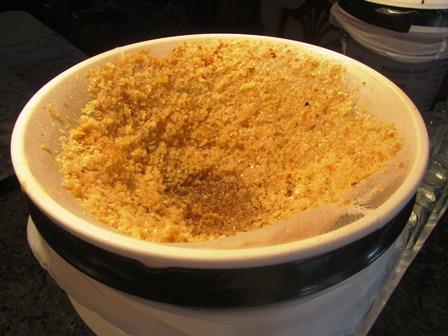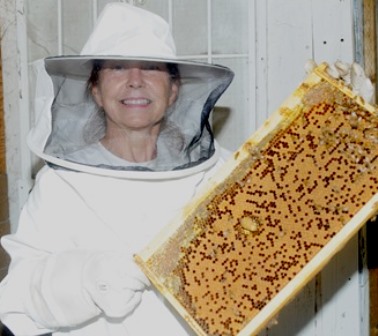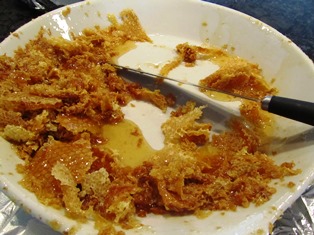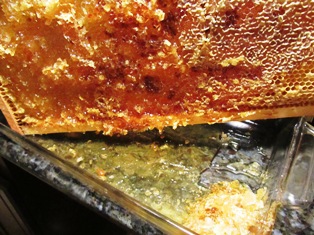First the Harvest, then the Floor
My kitchen floor was littered with bits of wax and bee glue yesterday. It took me over an hour on my knees to scrub and clean it after I had uncapped thirty frames of honey I’d taken from my hives.
In the process of scraping each frame and then unsealing all the capped cells on the front and back of each frame, drops of wax and propolis, or bee glue (created by the bees from bee saliva, wax, and exudate from botanical sources) fell to the floor. I tracked it from the counter, sink, and extractor on the soles of my shoes.
Even before I put my honey buckets under the extractor spigot, I tape fine mesh strainers over the buckets to catch wax and other debris.
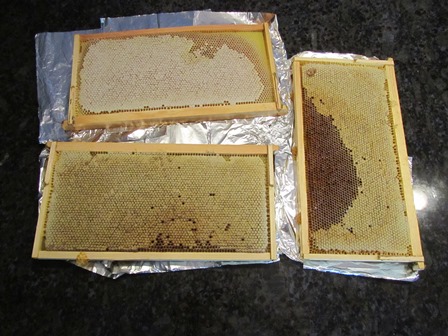
Three frames containing honey, but the sweet stuff is locked inside a honeycomb of cells sealed with wax by the bees
Once all the frames are processed and the buckets are sealed, I put the wax I’ve removed from the frames into a mesh bag to drain the honey (usually a much smaller quantity of honey is recovered from this process).
When the honey has been removed from the mesh bag, I place that wax on a cookie sheet and set it in the garden for the bees to clean. After the bees have cleaned all the wax (by eating any drops of honey left), I save the wax to melt into bars for candles or soap-making.
Back in in the kitchen, the extractor, it must be washed inside and out. Once cleaned and moved to the patio, I must start removing the wax and propolis from the floor. For that, I use an old thin, metal spatula to scrape the tile free of wax.
A soap and water scrub follows. Then I rinse and dry the floor with rags before moving the honey extractor back into the kitchen.
I won’t take honey again until next year. But now the honey must be bottled–that means I must sterilize bottles and prepare labels. Keeping honeybees is really only this labor intensive during and after the honey harvest. But the harvest is well worth all the work.
If you enjoy reading about farmette topics (including gardening, beekeeping, and delicious recipes), check out my cozy mysteries A BEELINE TO MURDER and also THE MURDER OF A QUEEN BEE in the Henny Penny Farmette series (from Kensington Publishing).
* * *
Enjoy reading about farming topics? Check out my cozy mysteries–A BEELINE TO MURDER and also THE MURDER OF A QUEEN BEE (both in the Henny Penny Farmette series from Kensington Publishing).
These novels are chocked full of recipes, farming tips, chicken and beekeeping tips, sayings and, of course, a charming cozy mystery. For more info, click on the links under the pictures.
The books are available through online retailers such as Amazon, Barnes & Noble, Kobo Books, and Walmart as well as from traditional bookstores everywhere.
See, http://tinyurl.com/hxy3s8q
This debut novel launched the Henny Penny Farmette series of mysteries and sold out its first press run. It’s now available in mass market paperback and other formats.
See, http://tinyurl.com/h4kou4g
NEWLY RELEASED! This, the second cozy mystery in the Henny Penny Farmette series, is garnering great reviews from readers and industry publications.
Harvesting Honey–A Labor of Love
Sitting in the middle of my kitchen is a three-story hive box with thirty frames of honey that needs to be extracted, filtered, and poured into jars.
My apiary is small–just two hives. Taking the honey is quite a labor-intensive activity. But it brings its own kind of joy. As pollinator populations decrease, keeping bees is a small thing I can do for all of us . . . for our planet.
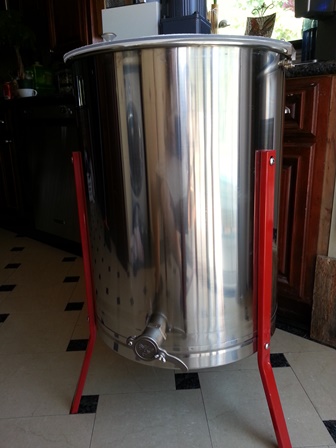
This electric honey extractor holds four frames; honey is spun out through centrifugal force and drains through the spigot
The stainless steel honey extractor, washed and scrubbed, has been pushed over by the oven to make a little space in my already-small kitchen.
Today, I washed the countertops, my stove, and even the sink with hot soapy water and bleach. Then after a thorough wipe-down, I stretched sheets of aluminum foil over the countertop. The extraction process started with four frames.
It’s a simple process. I set the four frames of honey on the foil-covered counter. Using a hot knife, I open the capped cells on both sides of the frames and put them in the honey extractor. Beneath the machine’s spigot, I’ve already positioned a five-gallon bucket with strainer attached. I start the machine on a slow speed and open the spigot.
Each of the five gallon and two-gallon buckets were previously washed and covered with strainers. These are held in place with heavy duty duct tape wrapped around the mouths. Switching out a full bucket for an empty one is easy when the buckets are prepped for use before the extraction starts.

Springtime honey appears golden in the frames whereas autumn honey is often darker (depending on what’s flowering, but often star thistle and eucalyptus, in my area)
I expect a yield of about thirty-five gallons this time. I lost one hive . . . more on that later, but, in all, it looks to be a good honey harvest for our family and friends.
As soon as I extract all the honey, I’ll start bottling it and affixing labels. It’s a process that will take several days to complete.
Tasting, smelling, and seeing all this golden, delicious honey that the bees created warms my heart. When we take care of them, they take care of us. And we always leave plenty of honey in the hives for the bees to eat throughout the winter.
* * *
If you enjoy reading about farmette topics (including gardening, beekeeping, and delicious recipes), check out my Henny Penny Farmette cozy mysteries series from Kensington Publishing.
These novels are chocked full of recipes, farming tips, and sayings as well as a charming cozy mystery.
See, http://tinyurl.com/hxy3s8q
This debut novel launched the Henny Penny Farmette series of mysteries and sold out its first press run. It’s now available in mass market paperback and other formats.
See, http://tinyurl.com/h4kou4g
JUST RELEASED! This, the second cozy mystery in the Henny Penny Farmette series, is garnering great reviews from readers and industry publications.
My books are available through online retailers such as Amazon, Barnes & Noble, Kobo Books, and Walmart as well as from traditional bookstores everywhere.
Harvesting Honey the Old-Fashioned Way
Last weekend, my beekeeper neighbor and I harvested three frames of honey from my hives. I took the frames into my house and, with a hot knife, cut open the wax cells to permit the honey to drain.
I drained off one-half gallon of honey from two frames.

Two frames drain simultaneously in a five-gallon bucket; another option is to use large, flat plastic tubs
I wrapped the extra frame in foil and froze it until I am ready to drain that frame as well. Then, I will let it thaw for 24 hours before draining off the honey.
Once all the honey is out of the frames, I take the frames outside and hang them in the tree near the hives. The honeybees will do the cleanup, foraging all the honey and leaving only clean wax that I can melt for candle- or soap-making projects.
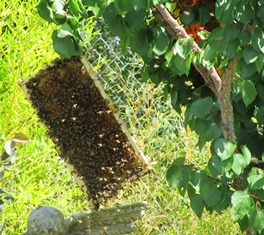
A frame of wax and residual honey is hung in a tree so the bees can clean it, hopefully before the ants find it
Draining honey from frames is a lengthy process and I have to do it twice: once to remove the honey and the second time to strain out any tiny particles of wax, before bottling it.
Last time, I took 20 frames and my neighbor, who was harvesting too, ran those 20 frames through his motorized extractor in his honey room.
Extractors are a modern convenience that saves untold hours extracting honey. But until I begin to sell my honey and other farm products, I won’t be able to afford such an energy-efficient tool.
I’ve discovered that beekeeping can be quite the expensive hobby. There are uncapping tubs, melters, comb cutting pans, heated knives, thermal plastic shrink bands for jars, uncapping needle rollers, and myriad other items used in honey extraction.
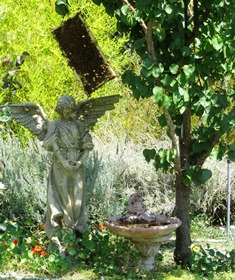
The tree near the hives holds two frames and a strainer of wax/honey from the uncapping of the cells that I also drained
Radial extractors can save time and preserves the honeycomb. The frames are placed between the guides of the stainless steel tank and the reel spins. The centrifugal force created throws honey against the sides of the tank. Honey is drained off through spigot. For now, the old-fashioned way works fine, too.
 Facebook
Facebook Goodreads
Goodreads LinkedIn
LinkedIn Meera Lester
Meera Lester Twitter
Twitter





